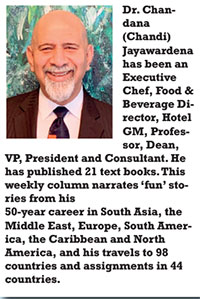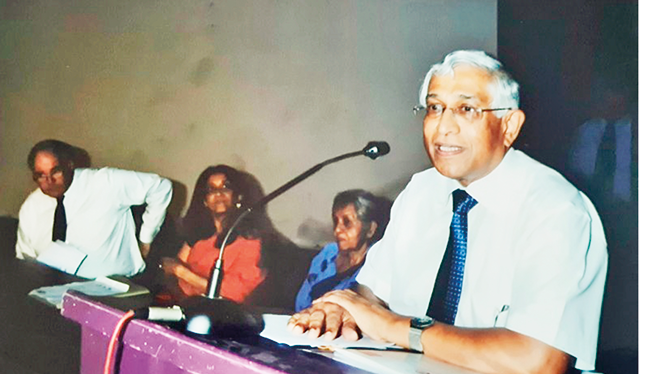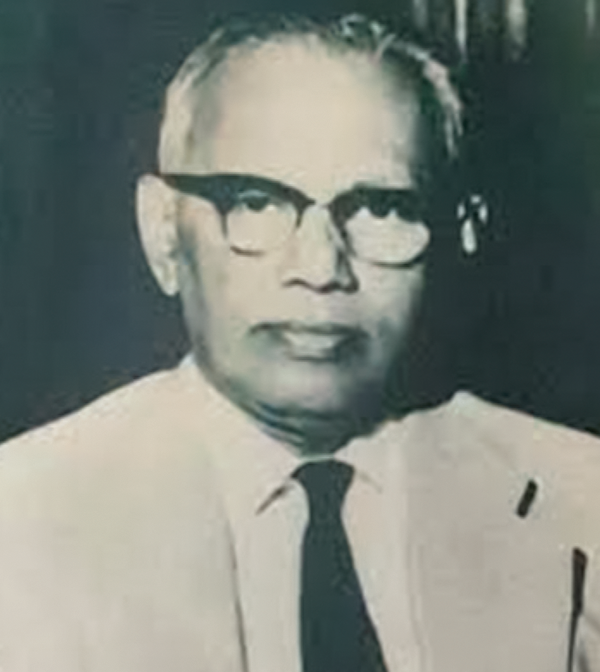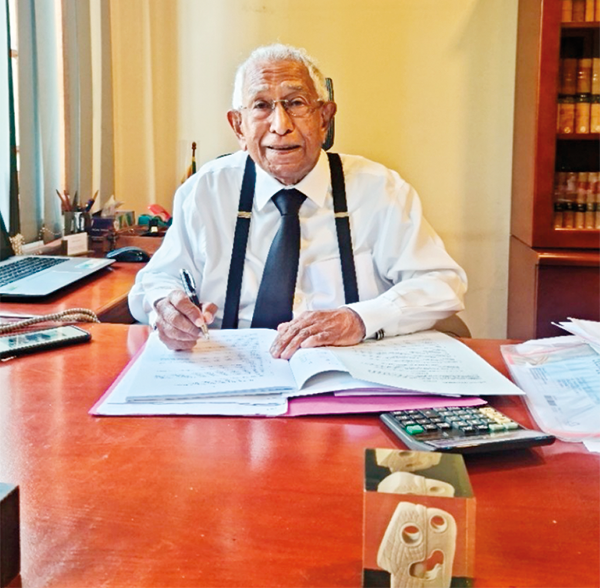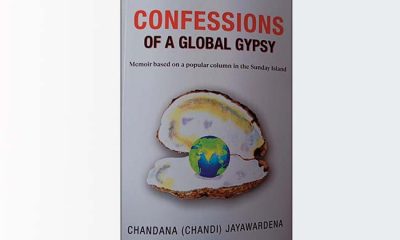Features
Simon (Sriyantha) Senaratne: Lawyer, CEO & Leisure Business Visionary
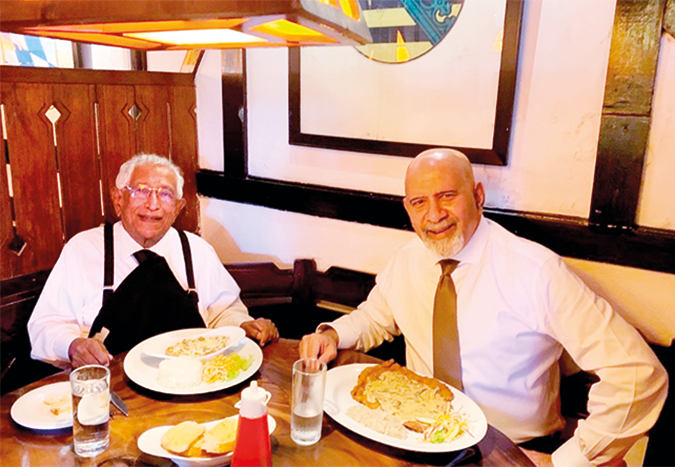
PLACES, PEOPLE & PASSIONS (3Ps)
Part five
Dr. Chandana (Chandi) Jayawardena DPhil
President – Chandi J. Associates Inc. Consulting, Canada
chandij@sympatico.ca
Profile
Simon is the founder and Precedent Partner of ‘Simon & Associates’, a well-established corporate law firm. He was the first Managing Director of ‘Walkers Tours’ the leisure arm of John Keells and led the development of their first hotel – Habarana Village. He was also one of the first Sri Lankan investors in the Maldives leisure industry. He is a social activist, an active Rotarian, and a past President of the Sri Lanka YMCA movement and the Ceylon Bible Society. His wife, Anthea, a short story writer, and Simon have two children and three grandchildren.
I have met Simon only four times over a period of 46 years: in 1977, 1980, 1983, and then after 40 years, in 2023. Each meeting was special, and I was inspired each time…
A Low-Key Leader
When I commenced working in resort hotels in the south coast of Sri Lanka in 1973, Walkers Tours & Travels Limited (later rebranded Walkers Tours) was the most influential and the leading tour operator in the island. They represented two of the largest European tour operators, from West Germany and Denmark, who were actively promoting tourism in Sri Lanka. Young hoteliers in the south coast loved dealing with fun-loving and friendly people who coordinated the Walkers Tours operations at hotels during that early stage of the organized tourism in Sri Lanka. They made us feel that we all were a big family involved in the building a young leisure industry in Sri Lanka.
Walkers Tours team who interacted with us regularly included Sri Lankan travel trade legends such as Norman Impett and Neville Arnolda, as well as their younger colleagues such as Christopher de Alwis, Bobby Jordan, and Jansi Ponniah. However, we only heard very little about their boss, who was a young lawyer, Sriyantha (Simon) Senaratne, who had been appointed as the Managing Director of Walkers Tours in 1971. Our friends respected their boss, who was the key business strategist in the corporate office but did not interfere with the operations experts of his company. That reflected the leadership style of a visionary leisure industry leader.
As a part of the business expansion vision of the Managing Director, Walkers Tours entered the hotel industry in 1973 with a unique project in a remote area – Habarana. After that Walkers Tours soon became the leader in hotel management in Sri Lanka. Just before the opening of the Village, Simon and his team finalized an agreement with Dr. Neville Fernando to manage his Hotel Swanee in Beruwala. After that, within the next two years, Walkers Tours took over the management of three other hotels. Those were Hotel Dulmini in Beruwala owned by a local businessman, Sanasuma Hotel in Weerawila owned by film idol Gamini Fonseka, and Hotel Ceysands in Bentota owned by Lalith Kotelawala. That was the foundation of the largest hotel company in Sri Lanka today.
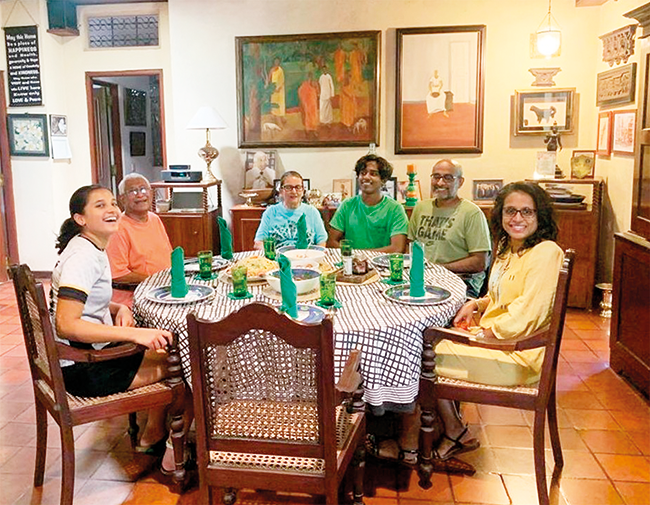
Simon having a relaxing meal at home with close family – (L to R) granddaughter Audrey, Simon, wife Anthea, grandson Akash, son-in-law Dinesh, and daughter Sonali
Our First Meeting in 1977
In the summer of 1977, Walkers Tours decided to organize a one-week-long coach tour around Sri Lanka for representatives from all hotels in Sri Lanka providing rooms to their clients. As the Assistant Manager and Executive Chef, I represented Coral Gardens Hotel in this tour. It turned out to be a fun-filled, thank you tour. It was a great, public relations initiative by Walkers Tours with their hotel industry partners.
The day after the trip when I returned to the Coral Gardens Hotel, Captain D. A Wickramasinghe (Captain Wicks), called me. He said that “I now work at the corporate office of John Keells/Walkers Tours Group, and I need to meet with you urgently to discuss something very important.” We met the next day. He explained that Walkers Tours had taken over the Hotel Ceysands management from the owners – Ceylinco Group, and Captain Wicks was appointed as the General Manager of Hotel Ceysands.
“I report to a fine gentleman, Mr. Sriyantha Senaratne, who has given me a free hand,” Captain Wicks said. I told him, “I have heard so many great things about Mr. Senaratne, but never had the pleasure of meeting him, yet.” After a few weeks, I joined the hotel re-opening team of Hotel Ceysands, as the Executive Chef and Food & Beverage Manager. I met Mr. Sriyantha Senaratne for the first time at Hotel Ceysands during our pre-opening period. I had a brief chat with this soft-spoken gentleman. I was impressed to hear that it was he who initiated the Habarana Village hotel project, despite a few barriers.
Job Offer in 1980
In 1980, Mr. Sriyantha Senaratne now as the Managing Director of rival company – Gemini Tours were completing the Sigiriya Village project. I was approached by the architect who designed both Habarana Village and Sigiriya Village – Somaratne de Silva, who made an offer to me to be the hotel opening Manager of the Sigiriya Village. “Simon and I are very impressed with you, and we would like you to join us” he said. It was an attractive offer, and I met Simon to thank him, but I did not accept the offer.
Chief Guest in 1983
In 1980 I married Captain Wicks’s daughter, and a year later commenced a family business with him – Streamline Services (Pvt.) Ltd., initially as a travel agency specializing in outbound travels, in Nepal, India and Thailand. As a Director of the company, I ran the Streamline Hotel Management Training Section. We had lectures on Saturdays and Sundays. With the increased business and student intake, we organized two award ceremonies a year.
Captain Wicks and I decided to invite two industry leaders whom we highly respected, as the chief guests of our award ceremonies – Mr. Herbert Cooray (Chairman of Jetwing Hotels Group, as well as the Tourist Hotels Association of Sri Lanka) and Mr. Sriyantha Senaratne (Managing Director of Gemini Management Services Ltd.). At the brink of the commencement of the civil war in Sri Lanka, he gave an inspiring keynote address to my students.
After meeting Mr. Senaratne at our 1983 awards ceremony, I lost touch with him for 40 years. Soon after the war started, I left for the United Kingdom to do my graduate studies, and Mr. Senaratne returned to his first love – law.
Re-connection after 40 years in 2023
After reading an episode of my newspaper column: ‘Confessions of a Global Gypsy’ dedicated to my time as the General manager of The Lodge and The Village, Habarana, I received more than the normal volume of reader’s mail. One was a long e-mail from a person with whom I had no contact for forty years – Mr. Sriyantha (Simon) Senaratne.
He wrote to me: “Chandana, this is a voice from the past. I have been following with great interest your series of articles on your life in the leisure industry appearing in the Sunday Island. Firstly, I want to thank you very much for the kind references that you have made about me personally in some of your articles. I would like to mention the background to Habarana Village, which almost did not happen.”
After exchanging a couple of further e-mails, he kindly agreed to collaborate with me in writing a question-and-answer article. During my last visit to Sri Lanka in March and April in 2023, we agreed to meet him after 40 years, in the well-appointed office of his law firm located in Galle Face Court II. After a nostalgic chat when we caught up our news of four decades over 40 minutes, he asked me: “Chandana, do you like German food?”
He then hosted me to lunch at the nearby Bavarian German Restaurant and Pub. Over lunch, I asked him the following 10 questions for this article. After that we communicated over a dozen e-mails clarifying and re-writing sections. As the old saying goes, “There ain’t no such thing as a free lunch!” especially when you are hosted by one of most successful corporate lawyers in the country!
Q: Out of all the places you have visited in Sri Lanka and overseas, what is your favorite and most interesting place?
A: Japan stands out in my memory as the most interesting, evocative and outstanding place I have visited. As one arrives you are immediately transported to an entirely different world and culture than you have ever experienced. The culture, manners and the discipline stands out in exceptional contrast to other places. Their rock gardens leaves you mesmerized. They are the most talented, cultured and most polite people I have ever met.
Q: Out of all the inspiring people you have met, who inspired you most?
A: I am an octogenarian and have been inspired by many people in my lifetime. At Trinity College I was exposed to the most committed and dedicated staff, who moulded my character. At the university it was Bishop Lakshman Wickremesinghe, a charismatic personality, brilliant intellect but yet a very simple, a down to earth human being. He taught me in life not to stand aside, but always to lend a hand to the less fortunate segments of our society.
In the law – At Julius & Creasy it was John Byrnell, the partner under whom I worked. He advised me “remember when you first meet a client he comes heavily burdened with his problems, when he leaves you, he must leave with the feeling that his burden is now on your shoulder.” He aptly summarized the very ethos of the profession, which has guided me all my life. In business – N. S. O. Mendis.
Q: At the present time, what is your key passion in life?
A: I have always believed that education is the only way to break through poverty. My wife and I make it a priority in our lives now, to fund the educational activities of the economically marginalized children in remote villages. We work in remotes villages in Anuradhapura, Vaharai and surrounding villages in the East Coast and in the deep South. I believe we have to give back what we have received.
Q: In leading a law firm with 500 corporate clients, what does your schedule look like on a normal work day?
A: During my early days of setting up the firm, I would work long hours virtually every single day, meeting clients, meeting counsel and travelling to sites which were of interest to my clients. Having established the firm on a good foundation, we have a brilliant, talented and efficient team of lawyers and chartered secretaries in whose hands I can confidently leave the nitty, gritty of running the firm. I still work every day, but with a lesser intensity. I balance my life, spending a lot of time with my family travelling together, working on our charity projects and reading widely and voraciously.
Q: In 1970 when you returned to Sri Lanka from the USA, you worked for one of the great corporate leaders in Ceylon of that period – Mr. N. S. O. Mendis. What are the key lessons you learnt from him?
A: Mr. N. S. O. Mendis had an extremely keen mind. He lived a simple life. In business he had a legendary ability to make investments. His visits to London were reviewed with apprehension by the sterling company directors, as they always wondered whether they would be the next acquisition. He had an excellent reputation with the London banks. In his operational style he left the day to day management entirely to the Directors whom he appointed and would have a fortnightly discussion with them.
The biggest lesson I learnt from him was when he told me “Sriyantha, in your business and professional life never ever lose your temper with the person sitting opposite you. Whatever outragous remark he would make, listen patiently and calmly and only then answer – a word spoken in anger can never be taken back.” I have never forgotten that lesson.
Q: At the age of 30, when you became the Managing Director at Walkers Tours, you were new to the leisure industry, but led a team of highly talented and experienced leisure industry professionals. How did you handle that?
A: When I became MD of Walkers Tours I had no experience whatsoever in the leisure industry. I was fortunate that there were experienced professional hands who were running Walkers Tours. In particular I would mention Neville Arnolda, and Norman Impett. I also recruited Christopher de Alwis who was an excellent PR person. I worked with the team and made them feel that they were partners and I believe that helped. I soon became quite experienced having met the CEO’s of the then two existing significant travel firms in Europe Hugo Stinnes, President of Neckemann Reisen and Pastor Krogager of Tjæreborg. They were very knowledgeable and I learnt much from them.
Q: By leading the Habarana Village project, as the first village style setting of a hotel in Sri Lanka, how did you make Walkers Tours, an innovative trend setter for others to follow?
A: I studied the operational pattern of the company and realized that the margins as a travel agent were extremely thin, but the highest margins were made by the hotel operators. When I analysed the tour patterns, I realized that most tourists visiting the cultural triangle divided their time between Sigiriya, Anuradhapura and Polonnaruwa. I saw an immediate opportunity for a hotel in a central location, as that would enable a three night stay in one hotel. Accordingly the idea for Habarana Village was born and of course it set a trend with the kind of village style cottages that were set up, instead of a conventional style hotel. For this concept credit belongs to the visionary architect Somaratne de Silva. This was a trend setter. I also believe that it set up another trend whereby travel companies also became owners of hotels where they were able to control the whole package.
Q: As one of the first Sri Lankan investors in the Maldives leisure industry, how did you inspire other organizations to follow your footsteps?
A: I visited the Maldives because I observed that some groups were travelling from Colombo to the Maldives and they spoke very highly of the Islands. At that time there were no direct flights from Europe to the Maldives. I visited the main island Male and an island called Vellasaru. I was struck by the pristine beaches and the turquoise blue water, the fish, of different shapes, colours and sizes, swimming around your feet as you got into the water and you could wade far into the sea as it was protected by a reef all around.
We had nothing comparable to that in Sri Lanka. I was struck by the contrast. I had a gut feeling that Maldives would in a few years be a magnet to tourists from all over the world, as each island captured privacy, as the other islands were spread far and wide in the Maldivian archipelago. I suppose the fact that I had invested in a hotel in the main island and in another separate island, made the industry here sit up and take notice.
Q: As a social activist, an active Rotarian, and a past President of the Sri Lanka YMCA movement and the Ceylon Bible Society, what were your main contributions to our society?
A: As President of the Rotary Club of Colombo North, the YMCA and the Bible Society, I became totally immersed in the activities of each different Society. My contribution to each of these societies was to ensure that their primary objects were properly funded, and encouraging and motivating a team to give of their best. The Rotary is a society which serves the community in welfare work.
It helps individuals, villages and projects in urban areas, helping to uplift the living standards of the people they reach out to. The YMCA too is a social movement that undertakes similar activities but is founded on the Christian principles. The Bible society is primarily involved in printing, publishing, distributing and translating the Bible to as many people as possible, thus spreading the word of God.
Q: You have worked very hard as a CEO for over 50 years. How do you balance your work and family life?
A: It has been a principle in my work life that I do not carry a file home. My home life has been devoted entirely to my wife and children and I ensured that I spent as much time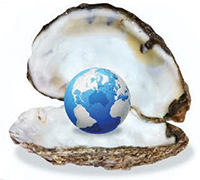 as possible with them and in particular when I needed to travel during my involvement with the leisure industry, whenever there was a conference out of the country I would take my entire family. I think my children benefited greatly being exposed to different cultures. Also in my hotel visits I would as far as possible take my family. As a matter of routine in my children’s younger days I would drop them at school and re-arrange my schedule to personally pick them up from school.
as possible with them and in particular when I needed to travel during my involvement with the leisure industry, whenever there was a conference out of the country I would take my entire family. I think my children benefited greatly being exposed to different cultures. Also in my hotel visits I would as far as possible take my family. As a matter of routine in my children’s younger days I would drop them at school and re-arrange my schedule to personally pick them up from school.
Next week, 3Ps will feature the Sri Lankan Chef par excellence, and a National Treasure…
Features
The heart-friendly health minister

by Dr Gotabhya Ranasinghe
Senior Consultant Cardiologist
National Hospital Sri Lanka
When we sought a meeting with Hon Dr. Ramesh Pathirana, Minister of Health, he graciously cleared his busy schedule to accommodate us. Renowned for his attentive listening and deep understanding, Minister Pathirana is dedicated to advancing the health sector. His openness and transparency exemplify the qualities of an exemplary politician and minister.
Dr. Palitha Mahipala, the current Health Secretary, demonstrates both commendable enthusiasm and unwavering support. This combination of attributes makes him a highly compatible colleague for the esteemed Minister of Health.
Our discussion centered on a project that has been in the works for the past 30 years, one that no other minister had managed to advance.
Minister Pathirana, however, recognized the project’s significance and its potential to revolutionize care for heart patients.
The project involves the construction of a state-of-the-art facility at the premises of the National Hospital Colombo. The project’s location within the premises of the National Hospital underscores its importance and relevance to the healthcare infrastructure of the nation.
This facility will include a cardiology building and a tertiary care center, equipped with the latest technology to handle and treat all types of heart-related conditions and surgeries.
Securing funding was a major milestone for this initiative. Minister Pathirana successfully obtained approval for a $40 billion loan from the Asian Development Bank. With the funding in place, the foundation stone is scheduled to be laid in September this year, and construction will begin in January 2025.
This project guarantees a consistent and uninterrupted supply of stents and related medications for heart patients. As a result, patients will have timely access to essential medical supplies during their treatment and recovery. By securing these critical resources, the project aims to enhance patient outcomes, minimize treatment delays, and maintain the highest standards of cardiac care.
Upon its fruition, this monumental building will serve as a beacon of hope and healing, symbolizing the unwavering dedication to improving patient outcomes and fostering a healthier society.We anticipate a future marked by significant progress and positive outcomes in Sri Lanka’s cardiovascular treatment landscape within the foreseeable timeframe.
Features
A LOVING TRIBUTE TO JESUIT FR. ALOYSIUS PIERIS ON HIS 90th BIRTHDAY

by Fr. Emmanuel Fernando, OMI
Jesuit Fr. Aloysius Pieris (affectionately called Fr. Aloy) celebrated his 90th birthday on April 9, 2024 and I, as the editor of our Oblate Journal, THE MISSIONARY OBLATE had gone to press by that time. Immediately I decided to publish an article, appreciating the untiring selfless services he continues to offer for inter-Faith dialogue, the renewal of the Catholic Church, his concern for the poor and the suffering Sri Lankan masses and to me, the present writer.
It was in 1988, when I was appointed Director of the Oblate Scholastics at Ampitiya by the then Oblate Provincial Fr. Anselm Silva, that I came to know Fr. Aloy more closely. Knowing well his expertise in matters spiritual, theological, Indological and pastoral, and with the collaborative spirit of my companion-formators, our Oblate Scholastics were sent to Tulana, the Research and Encounter Centre, Kelaniya, of which he is the Founder-Director, for ‘exposure-programmes’ on matters spiritual, biblical, theological and pastoral. Some of these dimensions according to my view and that of my companion-formators, were not available at the National Seminary, Ampitiya.
Ever since that time, our Oblate formators/ accompaniers at the Oblate Scholasticate, Ampitiya , have continued to send our Oblate Scholastics to Tulana Centre for deepening their insights and convictions regarding matters needed to serve the people in today’s context. Fr. Aloy also had tried very enthusiastically with the Oblate team headed by Frs. Oswald Firth and Clement Waidyasekara to begin a Theologate, directed by the Religious Congregations in Sri Lanka, for the contextual formation/ accompaniment of their members. It should very well be a desired goal of the Leaders / Provincials of the Religious Congregations.
Besides being a formator/accompanier at the Oblate Scholasticate, I was entrusted also with the task of editing and publishing our Oblate journal, ‘The Missionary Oblate’. To maintain the quality of the journal I continue to depend on Fr. Aloy for his thought-provoking and stimulating articles on Biblical Spirituality, Biblical Theology and Ecclesiology. I am very grateful to him for his generous assistance. Of late, his writings on renewal of the Church, initiated by Pope St. John XX111 and continued by Pope Francis through the Synodal path, published in our Oblate journal, enable our readers to focus their attention also on the needed renewal in the Catholic Church in Sri Lanka. Fr. Aloy appreciated very much the Synodal path adopted by the Jesuit Pope Francis for the renewal of the Church, rooted very much on prayerful discernment. In my Religious and presbyteral life, Fr.Aloy continues to be my spiritual animator / guide and ongoing formator / acccompanier.
Fr. Aloysius Pieris, BA Hons (Lond), LPh (SHC, India), STL (PFT, Naples), PhD (SLU/VC), ThD (Tilburg), D.Ltt (KU), has been one of the eminent Asian theologians well recognized internationally and one who has lectured and held visiting chairs in many universities both in the West and in the East. Many members of Religious Congregations from Asian countries have benefited from his lectures and guidance in the East Asian Pastoral Institute (EAPI) in Manila, Philippines. He had been a Theologian consulted by the Federation of Asian Bishops’ Conferences for many years. During his professorship at the Gregorian University in Rome, he was called to be a member of a special group of advisers on other religions consulted by Pope Paul VI.
Fr. Aloy is the author of more than 30 books and well over 500 Research Papers. Some of his books and articles have been translated and published in several countries. Among those books, one can find the following: 1) The Genesis of an Asian Theology of Liberation (An Autobiographical Excursus on the Art of Theologising in Asia, 2) An Asian Theology of Liberation, 3) Providential Timeliness of Vatican 11 (a long-overdue halt to a scandalous millennium, 4) Give Vatican 11 a chance, 5) Leadership in the Church, 6) Relishing our faith in working for justice (Themes for study and discussion), 7) A Message meant mainly, not exclusively for Jesuits (Background information necessary for helping Francis renew the Church), 8) Lent in Lanka (Reflections and Resolutions, 9) Love meets wisdom (A Christian Experience of Buddhism, 10) Fire and Water 11) God’s Reign for God’s poor, 12) Our Unhiddden Agenda (How we Jesuits work, pray and form our men). He is also the Editor of two journals, Vagdevi, Journal of Religious Reflection and Dialogue, New Series.
Fr. Aloy has a BA in Pali and Sanskrit from the University of London and a Ph.D in Buddhist Philosophy from the University of Sri Lankan, Vidyodaya Campus. On Nov. 23, 2019, he was awarded the prestigious honorary Doctorate of Literature (D.Litt) by the Chancellor of the University of Kelaniya, the Most Venerable Welamitiyawe Dharmakirthi Sri Kusala Dhamma Thera.
Fr. Aloy continues to be a promoter of Gospel values and virtues. Justice as a constitutive dimension of love and social concern for the downtrodden masses are very much noted in his life and work. He had very much appreciated the commitment of the late Fr. Joseph (Joe) Fernando, the National Director of the Social and Economic Centre (SEDEC) for the poor.
In Sri Lanka, a few religious Congregations – the Good Shepherd Sisters, the Christian Brothers, the Marist Brothers and the Oblates – have invited him to animate their members especially during their Provincial Congresses, Chapters and International Conferences. The mainline Christian Churches also have sought his advice and followed his seminars. I, for one, regret very much, that the Sri Lankan authorities of the Catholic Church –today’s Hierarchy—- have not sought Fr.
Aloy’s expertise for the renewal of the Catholic Church in Sri Lanka and thus have not benefited from the immense store of wisdom and insight that he can offer to our local Church while the Sri Lankan bishops who governed the Catholic church in the immediate aftermath of the Second Vatican Council (Edmund Fernando OMI, Anthony de Saram, Leo Nanayakkara OSB, Frank Marcus Fernando, Paul Perera,) visited him and consulted him on many matters. Among the Tamil Bishops, Bishop Rayappu Joseph was keeping close contact with him and Bishop J. Deogupillai hosted him and his team visiting him after the horrible Black July massacre of Tamils.
Features
A fairy tale, success or debacle

Sri Lanka-Singapore Free Trade Agreement
By Gomi Senadhira
senadhiragomi@gmail.com
“You might tell fairy tales, but the progress of a country cannot be achieved through such narratives. A country cannot be developed by making false promises. The country moved backward because of the electoral promises made by political parties throughout time. We have witnessed that the ultimate result of this is the country becoming bankrupt. Unfortunately, many segments of the population have not come to realize this yet.” – President Ranil Wickremesinghe, 2024 Budget speech
Any Sri Lankan would agree with the above words of President Wickremesinghe on the false promises our politicians and officials make and the fairy tales they narrate which bankrupted this country. So, to understand this, let’s look at one such fairy tale with lots of false promises; Ranil Wickremesinghe’s greatest achievement in the area of international trade and investment promotion during the Yahapalana period, Sri Lanka-Singapore Free Trade Agreement (SLSFTA).
It is appropriate and timely to do it now as Finance Minister Wickremesinghe has just presented to parliament a bill on the National Policy on Economic Transformation which includes the establishment of an Office for International Trade and the Sri Lanka Institute of Economics and International Trade.
Was SLSFTA a “Cleverly negotiated Free Trade Agreement” as stated by the (former) Minister of Development Strategies and International Trade Malik Samarawickrama during the Parliamentary Debate on the SLSFTA in July 2018, or a colossal blunder covered up with lies, false promises, and fairy tales? After SLSFTA was signed there were a number of fairy tales published on this agreement by the Ministry of Development Strategies and International, Institute of Policy Studies, and others.
However, for this article, I would like to limit my comments to the speech by Minister Samarawickrama during the Parliamentary Debate, and the two most important areas in the agreement which were covered up with lies, fairy tales, and false promises, namely: revenue loss for Sri Lanka and Investment from Singapore. On the other important area, “Waste products dumping” I do not want to comment here as I have written extensively on the issue.
1. The revenue loss
During the Parliamentary Debate in July 2018, Minister Samarawickrama stated “…. let me reiterate that this FTA with Singapore has been very cleverly negotiated by us…. The liberalisation programme under this FTA has been carefully designed to have the least impact on domestic industry and revenue collection. We have included all revenue sensitive items in the negative list of items which will not be subject to removal of tariff. Therefore, 97.8% revenue from Customs duty is protected. Our tariff liberalisation will take place over a period of 12-15 years! In fact, the revenue earned through tariffs on goods imported from Singapore last year was Rs. 35 billion.
The revenue loss for over the next 15 years due to the FTA is only Rs. 733 million– which when annualised, on average, is just Rs. 51 million. That is just 0.14% per year! So anyone who claims the Singapore FTA causes revenue loss to the Government cannot do basic arithmetic! Mr. Speaker, in conclusion, I call on my fellow members of this House – don’t mislead the public with baseless criticism that is not grounded in facts. Don’t look at petty politics and use these issues for your own political survival.”
I was surprised to read the minister’s speech because an article published in January 2018 in “The Straits Times“, based on information released by the Singaporean Negotiators stated, “…. With the FTA, tariff savings for Singapore exports are estimated to hit $10 million annually“.
As the annual tariff savings (that is the revenue loss for Sri Lanka) calculated by the Singaporean Negotiators, Singaporean $ 10 million (Sri Lankan rupees 1,200 million in 2018) was way above the rupees’ 733 million revenue loss for 15 years estimated by the Sri Lankan negotiators, it was clear to any observer that one of the parties to the agreement had not done the basic arithmetic!
Six years later, according to a report published by “The Morning” newspaper, speaking at the Committee on Public Finance (COPF) on 7th May 2024, Mr Samarawickrama’s chief trade negotiator K.J. Weerasinghehad had admitted “…. that forecasted revenue loss for the Government of Sri Lanka through the Singapore FTA is Rs. 450 million in 2023 and Rs. 1.3 billion in 2024.”
If these numbers are correct, as tariff liberalisation under the SLSFTA has just started, we will pass Rs 2 billion very soon. Then, the question is how Sri Lanka’s trade negotiators made such a colossal blunder. Didn’t they do their basic arithmetic? If they didn’t know how to do basic arithmetic they should have at least done their basic readings. For example, the headline of the article published in The Straits Times in January 2018 was “Singapore, Sri Lanka sign FTA, annual savings of $10m expected”.
Anyway, as Sri Lanka’s chief negotiator reiterated at the COPF meeting that “…. since 99% of the tariffs in Singapore have zero rates of duty, Sri Lanka has agreed on 80% tariff liberalisation over a period of 15 years while expecting Singapore investments to address the imbalance in trade,” let’s turn towards investment.
Investment from Singapore
In July 2018, speaking during the Parliamentary Debate on the FTA this is what Minister Malik Samarawickrama stated on investment from Singapore, “Already, thanks to this FTA, in just the past two-and-a-half months since the agreement came into effect we have received a proposal from Singapore for investment amounting to $ 14.8 billion in an oil refinery for export of petroleum products. In addition, we have proposals for a steel manufacturing plant for exports ($ 1 billion investment), flour milling plant ($ 50 million), sugar refinery ($ 200 million). This adds up to more than $ 16.05 billion in the pipeline on these projects alone.
And all of these projects will create thousands of more jobs for our people. In principle approval has already been granted by the BOI and the investors are awaiting the release of land the environmental approvals to commence the project.
I request the Opposition and those with vested interests to change their narrow-minded thinking and join us to develop our country. We must always look at what is best for the whole community, not just the few who may oppose. We owe it to our people to courageously take decisions that will change their lives for the better.”
According to the media report I quoted earlier, speaking at the Committee on Public Finance (COPF) Chief Negotiator Weerasinghe has admitted that Sri Lanka was not happy with overall Singapore investments that have come in the past few years in return for the trade liberalisation under the Singapore-Sri Lanka Free Trade Agreement. He has added that between 2021 and 2023 the total investment from Singapore had been around $162 million!
What happened to those projects worth $16 billion negotiated, thanks to the SLSFTA, in just the two-and-a-half months after the agreement came into effect and approved by the BOI? I do not know about the steel manufacturing plant for exports ($ 1 billion investment), flour milling plant ($ 50 million) and sugar refinery ($ 200 million).
However, story of the multibillion-dollar investment in the Petroleum Refinery unfolded in a manner that would qualify it as the best fairy tale with false promises presented by our politicians and the officials, prior to 2019 elections.
Though many Sri Lankans got to know, through the media which repeatedly highlighted a plethora of issues surrounding the project and the questionable credentials of the Singaporean investor, the construction work on the Mirrijiwela Oil Refinery along with the cement factory began on the24th of March 2019 with a bang and Minister Ranil Wickremesinghe and his ministers along with the foreign and local dignitaries laid the foundation stones.
That was few months before the 2019 Presidential elections. Inaugurating the construction work Prime Minister Ranil Wickremesinghe said the projects will create thousands of job opportunities in the area and surrounding districts.
The oil refinery, which was to be built over 200 acres of land, with the capacity to refine 200,000 barrels of crude oil per day, was to generate US$7 billion of exports and create 1,500 direct and 3,000 indirect jobs. The construction of the refinery was to be completed in 44 months. Four years later, in August 2023 the Cabinet of Ministers approved the proposal presented by President Ranil Wickremesinghe to cancel the agreement with the investors of the refinery as the project has not been implemented! Can they explain to the country how much money was wasted to produce that fairy tale?
It is obvious that the President, ministers, and officials had made huge blunders and had deliberately misled the public and the parliament on the revenue loss and potential investment from SLSFTA with fairy tales and false promises.
As the president himself said, a country cannot be developed by making false promises or with fairy tales and these false promises and fairy tales had bankrupted the country. “Unfortunately, many segments of the population have not come to realize this yet”.
(The writer, a specialist and an activist on trade and development issues . )

